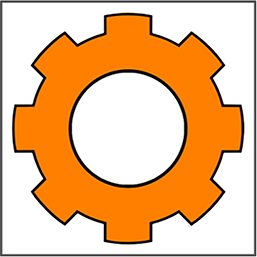- Linda Ellinwood & Jules Campbell + Inner Room guest: Lori Murphy’s Canaday Redacted
- The Gearbox Gallery – January 29 through March 13. 2021
- Fridays and Saturdays, noon to 5:00 pm
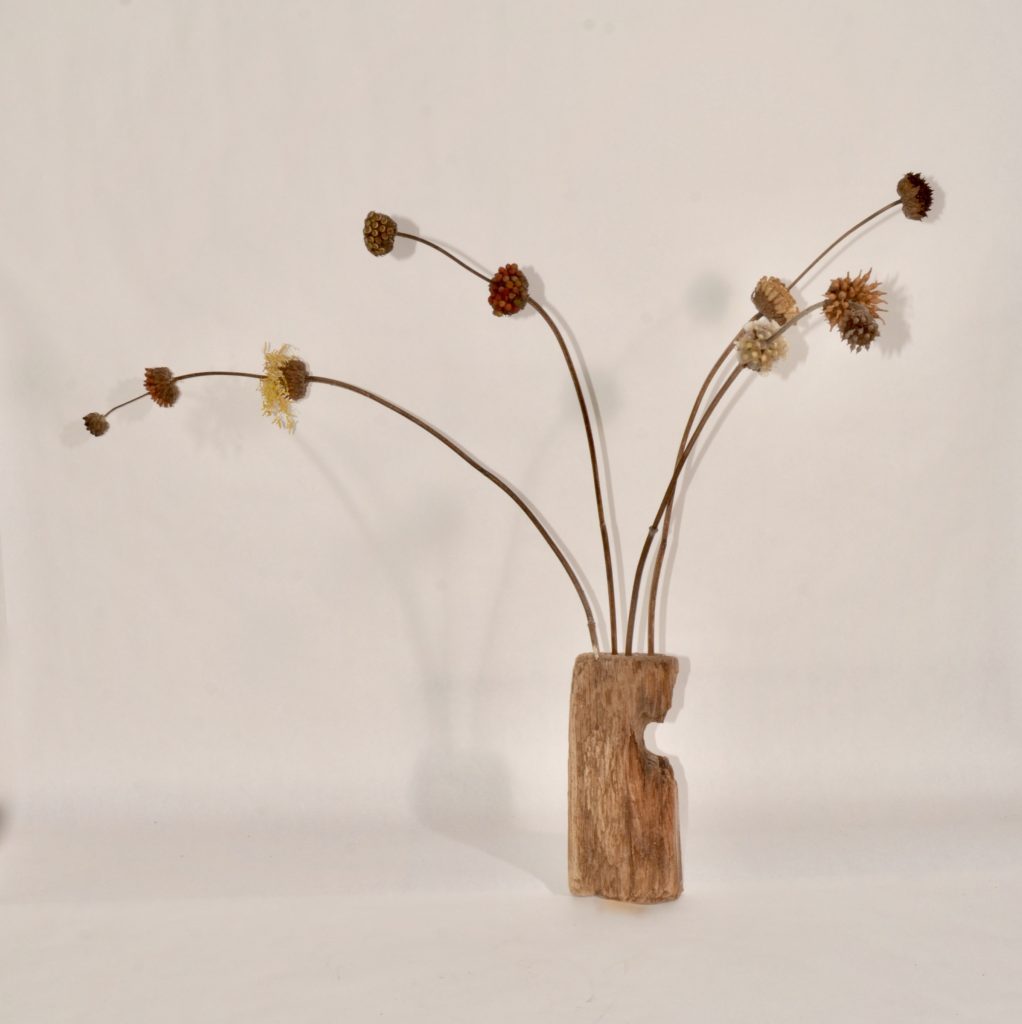
Well, Wednesday was just insane (referring to the insurrection at the US Capitol on January 6, 2021; a brief discussion of the anxiety we are all facing with the pandemic and political turmoil ensued).
Let’s talk about something more enjoyable by far; let’s talk about you and your art. I see that you got your MFA at CCAC in textiles.
Yes, but I actually began with a double major in sculpture and textiles. The textile faculty were more open to what I was doing. I never wove a thing!
And you got your BFA in Michigan and that was in painting. So you made quite a transition from painting to what you are doing now.
There were ten years between my degrees. I started moving toward three dimensions by working on pieces that were stuffed. I used a canvas as my base and sewed stuffed muslin components that seemed to drip from the top of the canvas to past the bottom.
So I have been looking at your pieces (Linda “walked” me through her studio with her iPad to show me her pieces for the exhibit and that gave me an understanding of the scale, from small to quite large). It’s great to see the shadows they cast and how they relate to each other as a group. What is the base of that one made of? (Bean Tree; see below for image and more dialogue.)
It’s burnt redwood. I sanded it and sealed the surface but, as you can see, I didn’t do the bottom (there was a sooty mark on the table). Well, you know Linda, when you become a famous artist, collected by all the major museums, this is going to be a conservator’s nightmare.
Yeah, right! (Laughter and a short discussion of Eva Hesse and Anselm Kiefer’s work and how they are disintegrating in museums around the world).
Symbiosis is kelp and a piece of driftwood. I just found the right pieces and they found each other. Not on the beach though; in my studio.
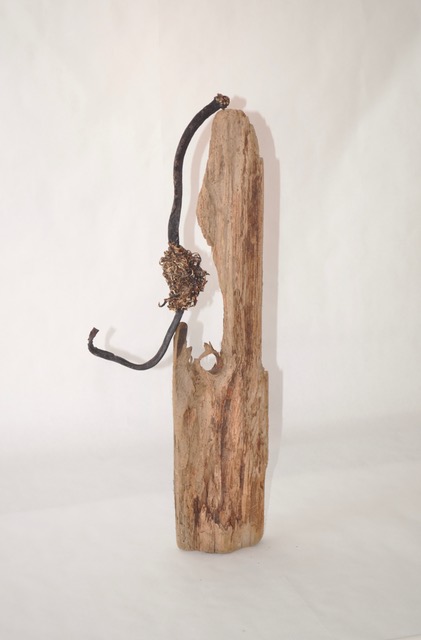
And this is Scout.
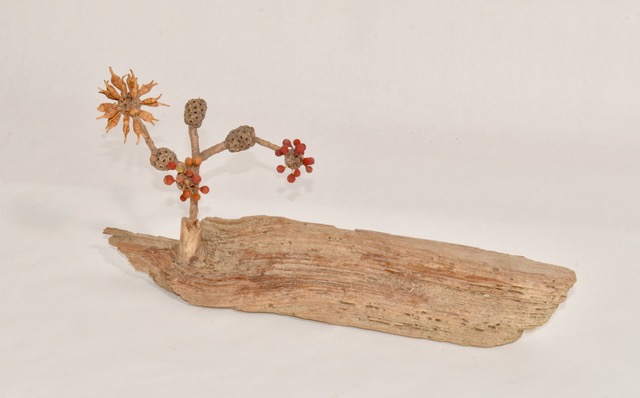
Ah, yes, it’s a bit different from the others. It reminds me of something more literal, like a landscape.
This one is large. These leaves are enormous. It’s called Fall.
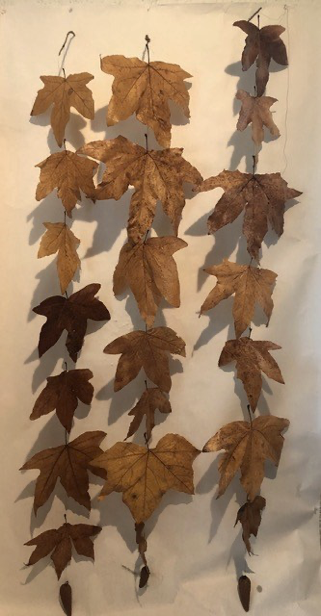
To me it means both the season and a feeling of falling or cascading. And I did have a question about how you preserve the leaves. I bought this tub of a glycerin mixture years ago that was called “Forever Natural.” Oh, I wonder if it would work on me! (laughter) It does preserve the color somewhat, although they darken a little. I soak the leaves in the solution for a day or so.
And what is that tiny little piece? Oh this is such a sweet piece. It’s called Migration.
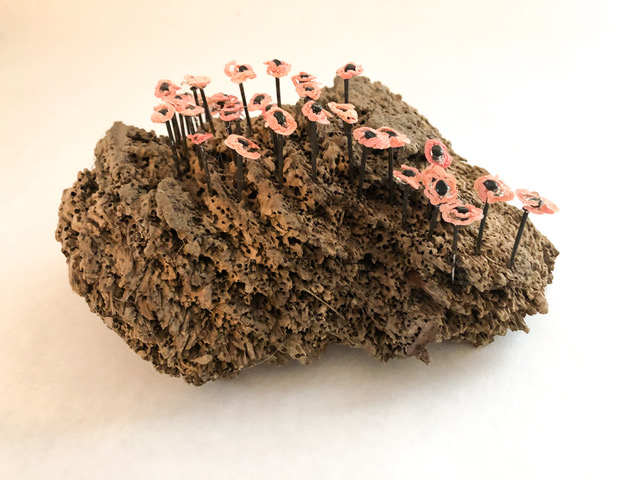
In this piece, Migration, those sort of pink acacia seeds, did you color them? No, I did not. So that is something I want to ask you about, the use of color. These pieces use natural color and most colors that exist in organic nature fade rather quickly. So is that part of what you are thinking of? I read somewhere that you are not creating these objects to last “till the end of time.”
I’ve had a lot of the things I use in my collection for a long time, for years and years. (Linda maintains a large collection of seeds, pods, and other organic materials.) So those colors are pretty static? Yes. I’ve had them in my house. They’re not in direct sunlight. Well, all the coloration is subtle and I am wondering, in making these objects over the years, if there is any material that is brilliantly colored. No. I picked the leaves for the Fall piece because they were yellow and I am trying consciously, this year, to get more color into my work. I have some acorns that were brilliant green and they faded, so quickly. (We had a discussion of natural color in leaves and other organic materials.)
So let’s talk about Conundrum. It may be my favorite of all of them.
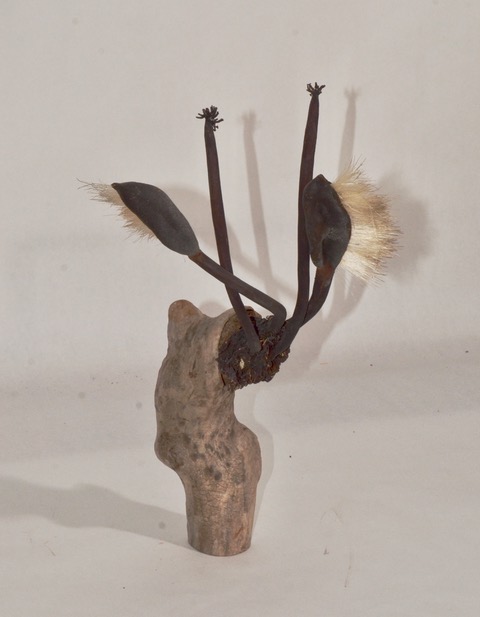
Well, there are some pods and kelp that are pieced together but you cannot see how they are joined; and artichoke fiber.
How do you come about naming your work? Very painfully! Conundrum means confusing or questionable or… It also has something to do with puns, so there is some humor in that as well. Does the name come after you finish a piece or sometimes before you begin? Always after… What is the process here? So someone gave me a bunch of kelp and I had the driftwood and I worked on it to sand and shape it and smoothed it out. I had the pods and I knew I wanted to attach them to the two broken kelp pieces. And then I had the artichoke fiber; I had picked up clumps. I mostly use Gorilla Glue to attach the pieces together.
Some of your objects become creatures. They become animistic or… They become animated. In this piece, Conundrum, it becomes animated for me and because of the shape of the wood base it also becomes feminine. It’s got a little bit of a threat to it…. That’s appropriate; women these days! (laughter)
Let’s go to Terpsicchore. I had to look that up. It’s the Greek muse of dancing and choral song. And it looks, in a way, like a Greek dance; because of the uniformity of the cones and the placement, they’re perfectly spaced. It has a sort of formality that you might see in a Greek dance.
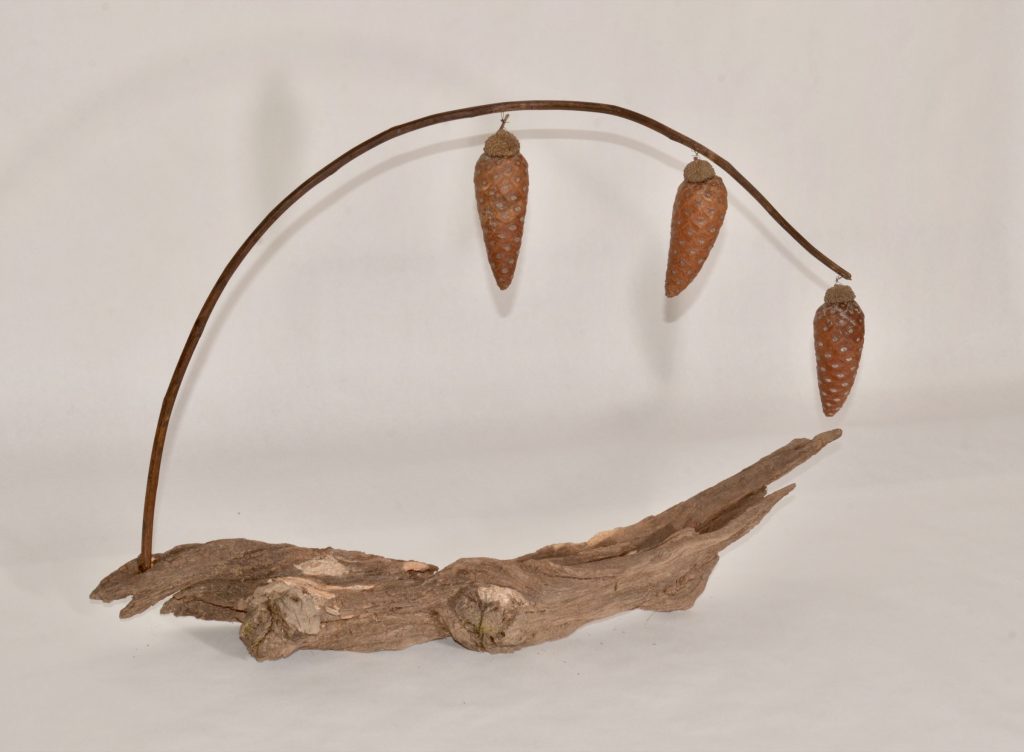
Yes, but then the base is totally not formal. Yes, for contrast.
So you have this really rough piece of driftwood and…
And a branch and cones… No, the tops of the cones are not parts of the cones, they are constructed with eucalyptus caps. The cones are juvenile, they haven’t opened up. Even after they fell from the tree? I cut them from the tree. Don’t worry, Linda, I’m not going to tell on you! (laughter) I did it in the open, not surreptitiously! I love the contrast between the elegant curve and these delicate cones hanging down and that wild and turbulent base. I struggled with this piece because the arc kept bending down due to the weight of the cones so I had to keep working it. Finally I got it to do what I wanted it to do. It also reminds me of a ship and movement. The bottom of it definitely has the quality of a ship.
Let’s look at Troika.
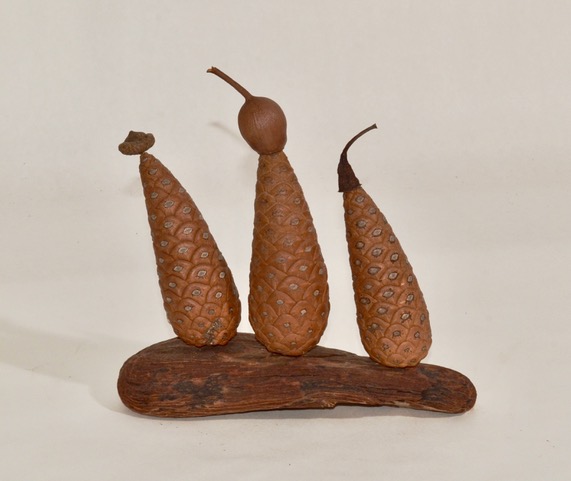
This one I find very whimsical. I knew the definition as three people that work together. But I wasn’t aware of the Russian definition of a vehicle pulled by three horses. Ah ha. I like the fact that they’re (the three cones) all leaning in the same direction, as if into the wind. Yes, they look like the Three Kings to me but I don’t want that to be just what people see. I had this incredible piece of redwood and it just came about. It was very quick. (Discussion of how both Linda and Jules – Jules Campbell, fellow artist member of The Gearbox Gallery – work in somewhat the same way.) Yes, sometimes I get a piece of something and it all comes together so quickly that it is almost shocking. But it’s out of the years that I have collected materials and made objects. It is just a part of me. Well, you’ve developed a language that you speak fluently. I mean if I were given a box of all this disparate stuff I would be totally perplexed. I wouldn’t have a clue! But you have a natural affinity for the material. Would you like to talk about any piece in particular?
Bean Tree.
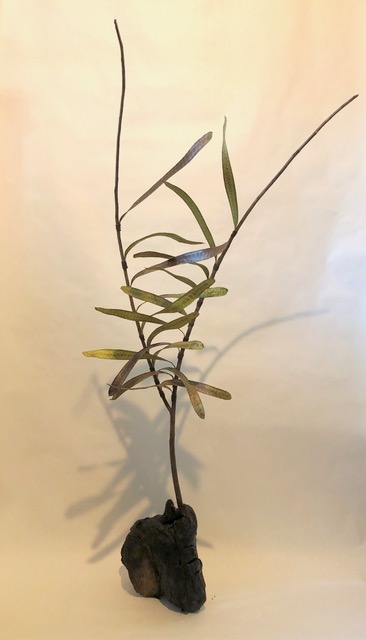
I even collect materials from the produce store and that is where I got those beans. They’re called guaje beans, from Mexico, and they’re a foot long and iridescent green. So when I look at the close-ups of the tiny beans in their pods I get this feeling of something prehistoric. They look sort of timeless, like something fossilized. These are all objects that you have made from things from the natural world that you have collected. Yet when you combine them and create these creatures they are taken out of the present. Do you think that at all? No. But I can see why you might go there.
When I start working on these, I see what is organically connected in each one. And whether that connection has a humorous quality or a serious one or a threatening one… I just enjoy what comes of these pieces that I end up putting together. I try to construct them in a way that they might have grown that way; not all of them but many of them. What I really want to have happen is for people to say, “Wow, these are just around where I am walking and I never noticed that,” and to start having that eye and appreciation for these beautiful things that are around us everywhere and for people to start seeing what’s there. That’s what I would really like to happen.
You said something about the character of these objects you make. I find a sense of whimsy in almost all of them. I’m looking at Hysteria now and I worked in a psychiatric ward for four years and this looks like a visual representation of a mental breakdown but it’s whimsical and funny. Yes, it makes you laugh.

So I always end these interviews of artists with the same question and that is, “Why do you do it?”
I struggle with that question. For a long time when I was growing up and I went to art school I had a long conflict between myself and doing something more obviously of service, to make a difference in the world. For a long time I couldn’t justify doing art work for that reason and… In my dotage (laughter) I’ve come to just… even though it is not easy for me to work… I belong to a critique group and we meet once a month and if I didn’t have that deadline I don’t think I’d have this show ready to go. I really enjoy it when I’m working but it is so hard for me to start. Even though I’ve collected all this stuff and it is all around me, to take the first step and engage in it is a struggle.
